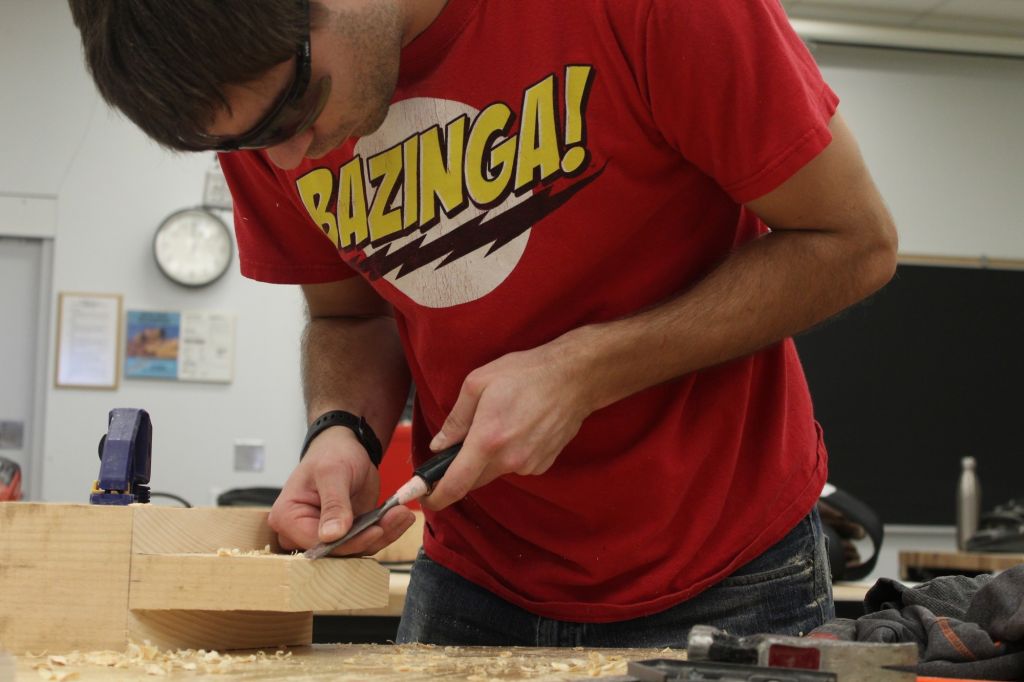Operating mitre saws with the blades rolling at full speed, students of the carpentry program carefully slice through sheets of plywood as they keep moving them around to make sure that the plywood is being cut into the right shapes.
Sawdust flies around the workshop like snowflakes that are blown by the wind. Students wear hard hats and goggles.
But they are not wearing dust masks, which protect them from the sawdust.
The risk behind carpenters who have no protection is high. According to information from Canadian Cancer Society, carpenters are listed among people who are most likely to be exposed to asbestos that are harmful to human lungs. This can potentially lead to lung cancer.
The concerns over this, however, can be eliminated, since the program has its own ways to deal with the sawdust which, to many non-professionals, seems to bother carpentry students.
“We have a dust extractor,” said Michael Nauth, professor of carpenter apprenticeship, while pointing at a big ventilation tube stretching across the workshop ceiling. “That pulls the dust out.”
The ventilation system is designed to minimize the airborne dust inhaled by people in the workshop. Equipment such as a handheld sander, which is a power tools that is used to smooth surfaces, are typically hooked up to vacuum cleaners to collect the dust.
That doesn’t mean they never wear the masks. Students still follow instructions and put on masks in some circumstances.
“It’s their choice if they want to wear dust masks,” said Nauth, “but usually when there’s a lot of sanding at the same time, they will wear dust masks.”
Air quality is not the only aspect that needs to be taken into consideration in carpentry industry.
Safety is also of the essence. A report presented by the Workplace Safety and Insurance Board, an Ontario government agency, shows that over the period from 2008 to 2017, construction accounts for the highest traumatic fatality percentages in terms of industry sectors. It reaches 30 per cent.
Except for basic safety training, the program also puts students under proper supervision in terms of tool operations. Students are not allowed to use the tools during breaks.
Some new students are uncertain and nervous about what they are working with. They are more likely to injure themselves with power tools. That is why they need mechanical protection when they find themselves facing emergency situations.
Greg Kenny, coordinator of the carpentry program, said that if students are not sure about what they’re doing, instructors will put them to work on a special kind of table saw, which is able to eliminate the potential risk by automatically stopping when the user unintentionally touches the blade on the machine.
“If they ever did touch the blade,” said Kenny while explaining the machine’s safety mechanism, “There are a few things that would happen. The electricity would cut, the blade will drop and there’s a break that hits the blade.”
Injuries do happen occasionally, but usually not with power tools. Instead, human error in using manual tool plays a major role.
“Because people respect power tools more,” said Kenny, “and they know the potential of injury.”
Despite the program’s demonstration and emphasis regarding how to use the manual tools in a safe way, students are prone to take shortcuts sometimes, which brings them trouble.
Sometimes students holds the wood on the table with one hand and the chisel with the other hand. Their hands slip and students cut themselves.
“I think two years ago we had a guy who needed stitches,” said Nauth. “He cut his hand with the chisel and he needed to go to doctor’s office to get couple of stitches.”
As more and more students graduate and work in construction program, safety conditions accumulate attention.
“I think we’re more onto it now than we’ve ever been,” said Kenny. “If we ever see our room for improvement, we usually act on it.”


